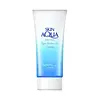What's inside
What's inside
 Key Ingredients
Key Ingredients

 Benefits
Benefits

 Concerns
Concerns

 Ingredients Side-by-side
Ingredients Side-by-side

Water
Skin ConditioningDimethicone
EmollientZinc Oxide
Cosmetic ColorantAlcohol
AntimicrobialIsododecane
EmollientEthylhexyl Methoxycinnamate
UV AbsorberTalc
AbrasiveOctocrylene
UV AbsorberPolysilicone-15
UV FilterSorbitan Sesquiisostearate
EmulsifyingSilica
AbrasiveEthylhexyl Salicylate
UV AbsorberTitanium Dioxide
Cosmetic ColorantGlycerin
HumectantDiisopropyl Sebacate
EmollientCaprylyl Methicone
Skin ConditioningBis-Ethylhexyloxyphenol Methoxyphenyl Triazine
Skin ConditioningHoney
HumectantOryza Sativa Germ Oil
EmollientSodium Hyaluronate
HumectantSericin
Skin ConditioningSodium Acetylated Hyaluronate
HumectantCamellia Sinensis Leaf Extract
AntimicrobialPPG-17
Skin ConditioningPEG-9 Polydimethylsiloxyethyl Dimethicone
EmulsifyingIsostearic Acid
CleansingHydrogen Dimethicone
Aluminum Hydroxide
EmollientStearic Acid
CleansingDisteardimonium Hectorite
StabilisingTrisodium EDTA
BHT
AntioxidantTocopherol
AntioxidantCitrus Aurantium Dulcis Peel Oil
MaskingButylene Glycol
HumectantSodium Metabisulfite
AntioxidantCitric Acid
BufferingPotassium Sorbate
PreservativeWater, Dimethicone, Zinc Oxide, Alcohol, Isododecane, Ethylhexyl Methoxycinnamate, Talc, Octocrylene, Polysilicone-15, Sorbitan Sesquiisostearate, Silica, Ethylhexyl Salicylate, Titanium Dioxide, Glycerin, Diisopropyl Sebacate, Caprylyl Methicone, Bis-Ethylhexyloxyphenol Methoxyphenyl Triazine, Honey, Oryza Sativa Germ Oil, Sodium Hyaluronate, Sericin, Sodium Acetylated Hyaluronate, Camellia Sinensis Leaf Extract, PPG-17, PEG-9 Polydimethylsiloxyethyl Dimethicone, Isostearic Acid, Hydrogen Dimethicone, Aluminum Hydroxide, Stearic Acid, Disteardimonium Hectorite, Trisodium EDTA, BHT, Tocopherol, Citrus Aurantium Dulcis Peel Oil, Butylene Glycol, Sodium Metabisulfite, Citric Acid, Potassium Sorbate
Water
Skin ConditioningButylene Glycol
HumectantEthylhexyl Methoxycinnamate
UV AbsorberAlcohol Denat.
AntimicrobialIsononyl Isononanoate
EmollientEthylhexyl Triazone
UV AbsorberSodium Hyaluronate
HumectantHydrolyzed Sodium Hyaluronate
Skin ConditioningHydroxypropyltrimonium Hyaluronate
Bis-Ethylhexyloxyphenol Methoxyphenyl Triazine
Skin ConditioningSilica
AbrasivePropanediol
SolventMethylene Bis-Benzotriazolyl Tetramethylbutylphenol
UV FilterDiethylamino Hydroxybenzoyl Hexyl Benzoate
UV FilterDiethoxyethyl Succinate
SolventPEG-40 Stearate
EmulsifyingPropylene Glycol
HumectantAcrylates/C10-30 Alkyl Acrylate Crosspolymer
Emulsion StabilisingDecyl Glucoside
CleansingCaprylhydroxamic Acid
Melaleuca Alternifolia Leaf Oil
AntioxidantBis-PEG-18 Methyl Ether Dimethyl Silane
EmollientPolysilicone-13
Disodium EDTA
Xanthan Gum
EmulsifyingPhenoxyethanol
PreservativeWater, Butylene Glycol, Ethylhexyl Methoxycinnamate, Alcohol Denat., Isononyl Isononanoate, Ethylhexyl Triazone, Sodium Hyaluronate, Hydrolyzed Sodium Hyaluronate, Hydroxypropyltrimonium Hyaluronate, Bis-Ethylhexyloxyphenol Methoxyphenyl Triazine, Silica, Propanediol, Methylene Bis-Benzotriazolyl Tetramethylbutylphenol, Diethylamino Hydroxybenzoyl Hexyl Benzoate, Diethoxyethyl Succinate, PEG-40 Stearate, Propylene Glycol, Acrylates/C10-30 Alkyl Acrylate Crosspolymer, Decyl Glucoside, Caprylhydroxamic Acid, Melaleuca Alternifolia Leaf Oil, Bis-PEG-18 Methyl Ether Dimethyl Silane, Polysilicone-13, Disodium EDTA, Xanthan Gum, Phenoxyethanol
 Reviews
Reviews

Ingredients Explained
These ingredients are found in both products.
Ingredients higher up in an ingredient list are typically present in a larger amount.
You might know this ingredient as Tinosorb S or Bemotrizinol. It is a UV filter that covers both UVA and UVB rays.
This ingredient has two peak UV absorption peaks ( 310 and 340 nm) and is able to absorb both UV-A and UV-B rays. This ingredient works by preventing UV rays from reaching and damaging your skin.
On top of that - it is highly photostable and helps prevent the photodegration of other sunscreen ingredients such as avobenzone.
Tinosorb S is allowed in the EU, Australia, and Asia. It is close to being approved by the FDA and we'll hopefully get this ingredient in the U.S. by late 2025.
Fun fact: Tinosorb S is the most effective UV absorber at maximum concentration (measured by SPF) permitted in the EU.
This ingredient is oil-soluble, so your oil-cleansers will take this right off at night.
Learn more about Bis-Ethylhexyloxyphenol Methoxyphenyl TriazineButylene Glycol (or BG) is used within cosmetic products for a few different reasons:
Overall, Butylene Glycol is a safe and well-rounded ingredient that works well with other ingredients.
Though this ingredient works well with most skin types, some people with sensitive skin may experience a reaction such as allergic rashes, closed comedones, or itchiness.
Learn more about Butylene GlycolEthylhexyl Methoxycinnamate is an organic compound that provides UVB protection. It often goes by the more common name of octinoxate. It is created from methoxycinnamic acid and 2-ethylhexanol.
Ethylhexyl Methoxycinnamate absorbs UVB rays with wavelengths between 280-320 nm. UV absorbers protect your skin by using chemical reactions to convert UV rays into heat and energy.
UVB (290-320 nm) rays emit more energy than UVA rays. They are capable of damaging DNA, causing sunburns and are thought to be linked to skin cancer.
The state of Hawaii has banned sunscreens containing octinoxate due to its potential impact on coral reefs. More research is needed to bridge gaps in this research. The European Union allows higher levels of octinoxate in sunscreens than the US and Australia.
Ethylhexyl Methoxycinnamate is oil soluble. It is not stable and may lose efficacy when exposed to sunlight.
Learn more about Ethylhexyl MethoxycinnamateSilica, also known as silicon dioxide, is a naturally occurring mineral. It is used as a fine, spherical, and porous powder in cosmetics.
Though it has exfoliant properties, the function of silica varies depending on the product.
The unique structure of silica enhances the spreadability and adds smoothness, making it a great texture enhancer.
It is also used as an active carrier, emulsifier, and mattifier due to its ability to absorb excess oil.
In some products, tiny microneedles called spicules are made from silica or hydrolyzed sponge. When you rub them in, they lightly polish away dead skin layers and enhance the penetration of active ingredients.
Learn more about SilicaSodium Hyaluronate is hyaluronic acid's salt form. It is commonly derived from the sodium salt of hyaluronic acid.
Like hyaluronic acid, it is great at holding water and acts as a humectant. This makes it a great skin hydrating ingredient.
Sodium Hyaluronate is naturally occurring in our bodies and is mostly found in eye fluid and joints.
These are some other common types of Hyaluronic Acid:
Learn more about Sodium HyaluronateWater. It's the most common cosmetic ingredient of all. You'll usually see it at the top of ingredient lists, meaning that it makes up the largest part of the product.
So why is it so popular? Water most often acts as a solvent - this means that it helps dissolve other ingredients into the formulation.
You'll also recognize water as that liquid we all need to stay alive. If you see this, drink a glass of water. Stay hydrated!
Learn more about Water